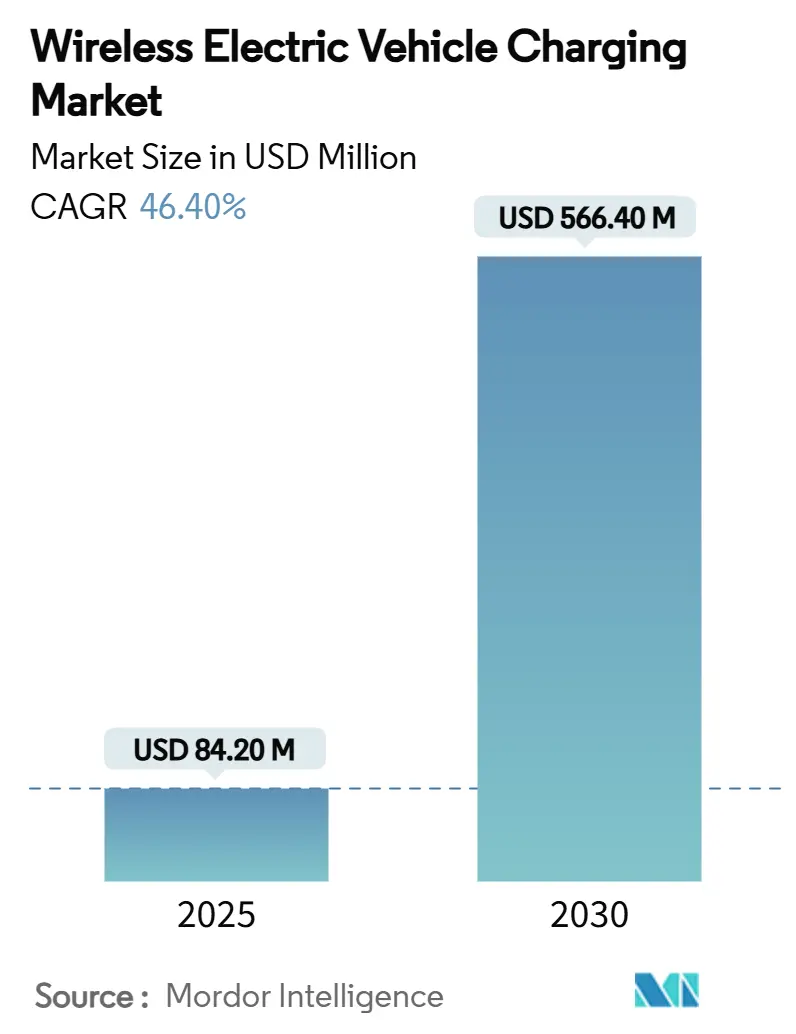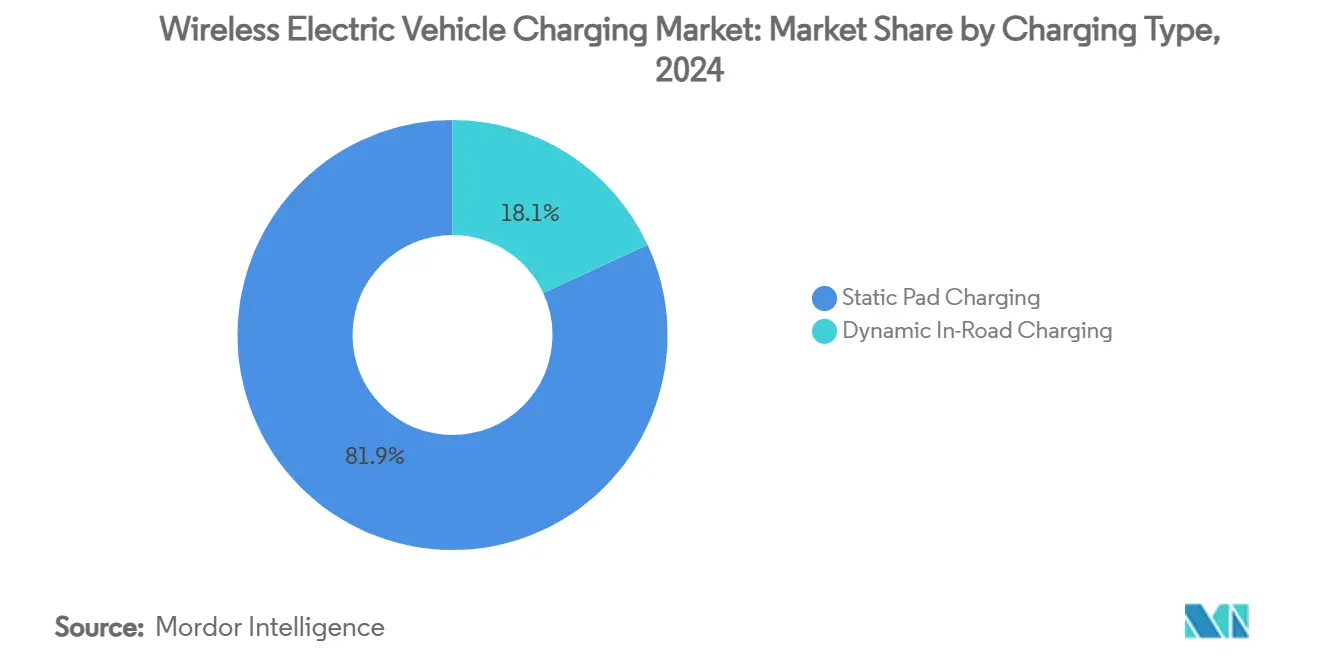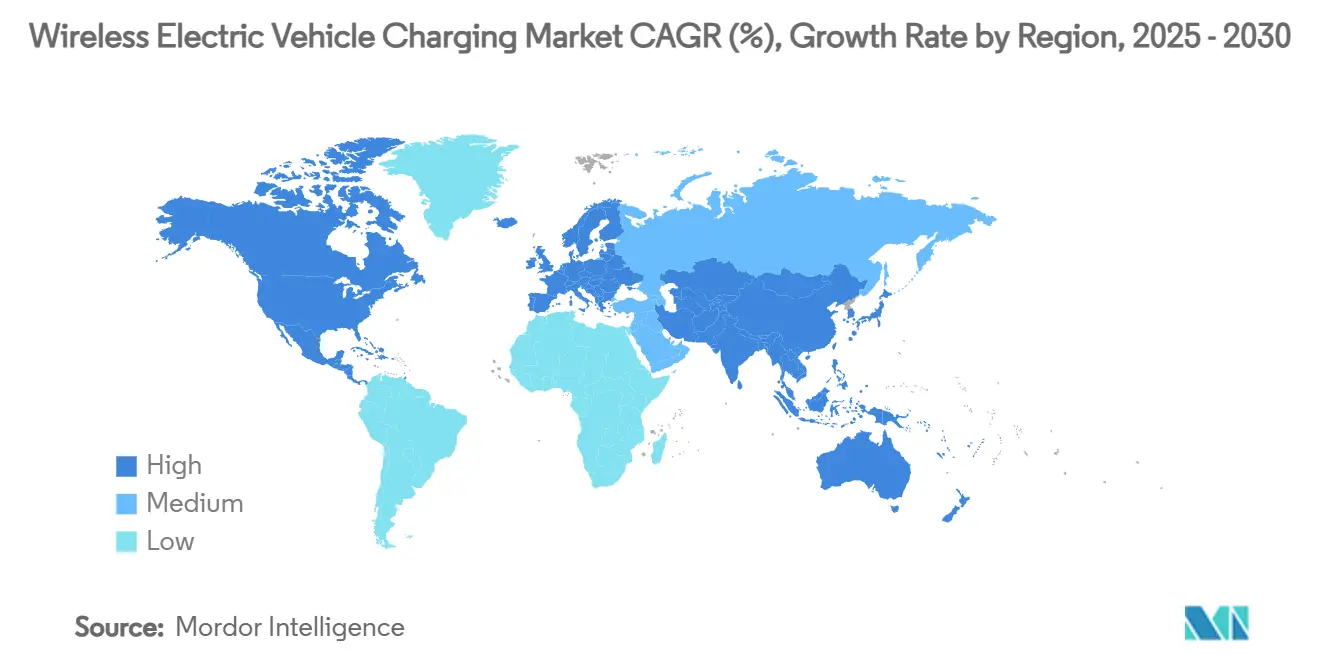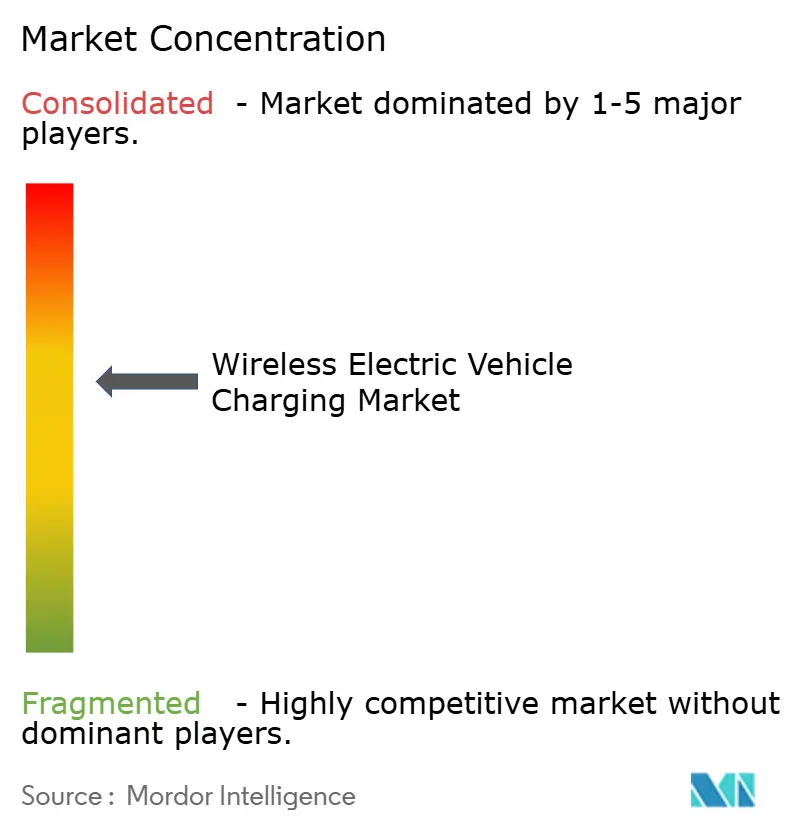
Wireless Electric Vehicle Charging Market Analysis by Mordor Intelligence
The wireless EV charging market stands at USD 84.23 million in 2025 and is projected to reach USD 566.46 million by 2030, advancing at a 46.40% CAGR during the forecast period (2025-2030). Investment momentum reflects the shift from laboratory pilots to revenue-generating deployments, accelerated by Tesla’s purchase of Wiferion and the release of the SAE J2954 standard in August 2024. Automakers now view the technology as a differentiator because conventional plug-in infrastructure in major cities is approaching saturation. Europe commands the largest regional demand today, yet China’s rapid build-out of charging points positions Asia-Pacific as the fastest-growing arena. Across all regions, fleet operators underscore that wireless charging lowers labor costs and unlocks high utilization rates, reinforcing technology adoption despite higher capital expenditure.
Key Report Takeaways
- By charging type, static pad systems led with 81.90% of wireless EV charging market share in 2024, while dynamic in-road solutions are forecast to climb at a 62% CAGR to 2030.
- By vehicle type, passenger cars held 65.20% of wireless EV charging market revenue share in 2024; buses and coaches are projected to expand at a 48% CAGR through 2030.
- By power output, up to 11 kW units accounted for 57.80% of the wireless EV charging market size in 2024, whereas installations above 150 kW are set to grow at a 70% CAGR over the same period.
- By installation site, home garages represented 71.20% of the wireless EV charging market size in 2024, while highway lane projects exhibit the highest outlook at a 57% CAGR.
- By technology platform, inductive resonant coupling led with 74.30% of the wireless EV charging market share in 2024, while magnetic field alignment multi-coil systems are forecast to grow at a 66% CAGR through 2030.
- By geography, Europe led with 38.20% of the wireless EV charging market share in 2024; Asia-Pacific is advancing at a 43% CAGR to 2030.
Global Wireless Electric Vehicle Charging Market Trends and Insights
Drivers Impact Analysis
| Driver | (~) % Point Impact on Market CAGR | Geographic Relevance | Impact Timeline |
|---|---|---|---|
| Rapid Acceleration In Global EV Sales | +12.5% | Global, with concentration in China, Europe, North America | Medium term (2-4 years) |
| Extended Government ZEV Mandates & Incentives | +8.2% | North America & EU, expanding to Asia-Pacific | Long term (≥ 4 years) |
| Early OEM Integration Into Premium Models | +7.8% | Global, led by German and Japanese automakers | Short term (≤ 2 years) |
| Fleet Electrification Demand For Autonomous Depot Charging | +6.9% | North America & EU, pilot projects in Asia-Pacific | Medium term (2-4 years) |
| Urban Anti-Cable Regulations & Curbside Inductive Pads | +4.1% | European cities, select North American municipalities | Long term (≥ 4 years) |
| Emerging SAE J2954-2 More Than 300 Kw Standard | +3.7% | Global, with early adoption in North America | Medium term (2-4 years) |
| Source: Mordor Intelligence | |||
Rapid Acceleration in Global EV Sales
Global electric vehicle sales momentum creates unprecedented demand for differentiated charging solutions, with wireless technology emerging as a premium feature that commands higher margins for automakers. Tesla's strategic acquisition of Wiferion in August 2024 signals the technology's maturation beyond experimental phases, while WiTricity's establishment of a Japanese subsidiary in May 2024 demonstrates coordinated global expansion efforts.[1]"WiTricity Corporation, a U.S. company that manufactures EV wireless power transfer products, establishes a Japanese subsidiary in Tokyo", Japan External Trade Organization, www.jetro.go.jp. The convergence of autonomous vehicle development with wireless charging is exemplified by Tesla filing four wireless charging patents in September 2024 targeting robotaxi applications where human intervention is impractical. This technological alignment suggests wireless charging will transition from luxury convenience to operational necessity as mobility services scale.
Extended Government ZEV Mandates & Incentives
Zero-emission vehicle mandates increasingly recognize infrastructure limitations as barriers to adoption, prompting governments to incentivize wireless charging deployment through targeted subsidies and regulatory frameworks. Japan's consideration of subsidies for Tesla's charging stations within broader tariff negotiations illustrates how wireless technology becomes entangled with trade policy and industrial competitiveness. The SAE J3400 standard's establishment as a Recommended Practice in September 2024 provides regulatory clarity that enables government procurement programs to specify wireless charging requirements for public fleets.[2]"SAE Task Force Votes to Establish J3400 Standard as Recommended Practice", Joint Office of Energy and Transportation, driveelectric.gov. European cities' exploration of anti-cable regulations for curbside parking creates a regulatory pull that complements a technology push, particularly as urban planners seek to eliminate visual pollution from charging infrastructure while maintaining accessibility.
Early OEM Integration into Premium Models
Automotive manufacturers leverage wireless charging as a differentiation strategy in premium segments, where technology premiums align with consumer willingness to pay for convenience features. BMW's collaboration with WiTricity on the 530e iPerformance represents the first commercially available wireless charging-enabled hybrid, establishing a template for luxury market penetration. Continental's announcement of an 11 kW wireless inductive charging system for production by the decade's end, along with BMW and Mercedes-Benz's planning implementation, signals coordinated industry movement toward standardization. The technology's integration with human-machine interface apps that guide precise vehicle positioning demonstrates how wireless charging enables broader automation strategies, positioning it as an enabler for autonomous parking and charging sequences.
Fleet Electrification Demand for Autonomous Depot Charging
Commercial fleet operators increasingly view wireless charging as an operational imperative rather than a convenience feature, particularly for depot-based applications where labor costs for manual charging exceed technology premiums. The Antelope Valley Transit Authority's deployment of three 250 kW inductive chargers from WAVE demonstrates how high-power wireless systems enable continuous fleet operations without dedicated charging personnel. Electreon's Charging as a Service model eliminates upfront infrastructure investment while reducing battery capacity requirements by 50%, creating compelling total cost of ownership propositions for fleet operators. The technology's alignment with autonomous vehicle development creates synergistic value propositions, as demonstrated by Michigan's partnership with Electreon and Xos for wireless-charged delivery vehicles that operate without human intervention.
Restraints Impact Analysis
| Restraint | (~) % Point Impact on Market CAGR | Geographic Relevance | Impact Timeline |
|---|---|---|---|
| High System & Installation Costs | -15.3% | Global, particularly acute in price-sensitive markets | Short term (≤ 2 years) |
| Interoperability & Standards Gaps | -8.7% | Global, with regional variations in adoption | Medium term (2-4 years) |
| Electro-Magnetic Safety Concerns In Dense Urban Zones | -6.2% | Urban areas globally, stricter in EU and Japan | Medium term (2-4 years) |
| Grid Harmonics Constraints On Megawatt In-Road Lanes | -3.4% | Highway corridors with high-power dynamic charging | Long term (≥ 4 years) |
| Source: Mordor Intelligence | |||
High System & Installation Costs
Wireless charging systems command 2-3 times the cost of equivalent wired solutions, creating significant barriers to mass market adoption despite improving technology economics. WiTricity's 11 kW wireless charger carries a USD 3,500 price point with installation costs ranging USD 3,500-4,000, compared to traditional Level 2 chargers priced below USD 1,000 installed. Infrastructure deployment costs prove even more challenging, with dynamic charging lanes requiring approximately EUR 167 million investment compared to EUR 105 million for equivalent fast-charging stations, though both scenarios yield similar net present values over extended timeframes.[3]"A Corridor-Based Approach to Estimating the Costs of Electric Vehicle Charging Infrastructure on Highways", MDPI, www.mdpi.com.The cost differential becomes particularly acute for public infrastructure deployment, where municipalities must justify premium pricing against limited utilization rates in early adoption phases.
Interoperability & Standards Gaps
Technical standardization challenges persist despite SAE J2954's establishment, as competing technology platforms pursue proprietary advantages that fragment market development. The distinction between inductive resonant coupling and magnetic field alignment multi-coil systems creates compatibility concerns for infrastructure investors uncertain about future technology convergence.Patent landscape complexity, exemplified by Mojo Mobility's USD 192 million victory against Samsung for wireless charging patent infringement, creates legal uncertainties that discourage infrastructure investment. Regional variations in electromagnetic field exposure limits and safety standards further complicate global deployment strategies, as manufacturers must navigate different regulatory frameworks across key markets while maintaining cost-effective production scales.
Segment Analysis
By Charging Type: Static Dominance Enables Dynamic Future
Static pad charging maintains commanding 81.90% of the wireless electric vehicle charging market share in 2024, reflecting current commercial viability and consumer acceptance patterns, while dynamic in-road charging accelerates at 62% CAGR through 2030 as infrastructure investments target long-term mobility transformation. Static systems benefit from established installation protocols and proven reliability, as demonstrated by WiTricity's deployment across multiple automotive partnerships and Electreon's successful bus terminal implementations in Israel and Germany. Dynamic charging applications remain concentrated in pilot projects and specialized corridors. Yet, Michigan's 14th Street deployment and Sweden's Smartroad Gotland demonstrate commercial viability for heavy-duty applications where continuous charging enables smaller battery configurations.
The technology maturation timeline favors static solutions for immediate market development, while dynamic systems require coordinated infrastructure investment beyond individual vehicle purchase decisions. Oak Ridge National Laboratory's achievement of 270 kW wireless power transfer represents a breakthrough that bridges static and dynamic applications, as the same polyphase electromagnetic coupling technology enables both stationary and mobile charging scenarios. Dynamic charging's growth trajectory depends on public-private partnerships that align infrastructure investment with fleet electrification schedules, creating network effects that justify premium technology costs through operational efficiency gains.

By Vehicle Type: Commercial Fleets Drive Premium Adoption
Passenger cars command 65.20% of the wireless electric vehicle charging market share in 2024, yet buses and coaches emerge as the fastest-growing segment at 48% CAGR, reflecting commercial operators' willingness to pay technology premiums for operational advantages that reduce total cost of ownership. Light commercial vehicles and medium & heavy trucks represent emerging applications where wireless charging enables autonomous depot operations without human intervention for charging procedures. Plug-in hybrid cars maintain steady demand as transitional technology, though their growth prospects diminish as battery electric vehicles achieve cost parity and charging infrastructure expands.
Fleet applications demonstrate superior economics compared to individual consumer adoption, as centralized depot charging enables standardized installation and maintenance procedures while maximizing utilization rates. The Port of Los Angeles's implementation of 500 kW wireless charging systems for heavy-duty trucks illustrates how commercial applications justify premium pricing through operational efficiency gains and emissions compliance requirements. Buses and coaches particularly benefit from wireless technology's alignment with fixed route operations, where predictable charging schedules enable optimized battery sizing and reduced infrastructure complexity compared to opportunity charging with manual connections.
By Power Output: Megawatt Migration Accelerates
Up to 11 kW systems dominate current installations with 57.80% of the wireless electric vehicle charging market share in 2024, reflecting residential and light commercial applications where power requirements align with existing electrical infrastructure capabilities, while above 150 kW installations surge at 70% CAGR as commercial applications demand rapid charging capabilities. The 11-50 kW segment serves as a bridge technology for workplace and retail applications, while 51-150 kW systems target fleet depot installations where moderate power levels balance charging speed with infrastructure costs. Above 150 kW applications represent the technology frontier, where megawatt-class systems enable dynamic charging for heavy-duty vehicles and high-utilization commercial fleets.
Power output evolution reflects broader industry trends toward extremely fast charging, as demonstrated by ChargePoint's introduction of megawatt charging systems capable of delivering up to 3 megawatts for commercial applications. Wireless technology's power scaling challenges require advanced thermal management and electromagnetic field control, yet breakthrough developments like Oak Ridge National Laboratory's 270 kW demonstration prove technical feasibility for high-power applications. The power output distribution suggests market bifurcation between residential convenience applications and commercial efficiency solutions, with limited overlap in technology requirements and pricing strategies.
By Installation Site: Home Foundation Supports Highway Future
Home garages capture 71.20% of the wireless electric vehicle charging market share in 2024, establishing wireless charging as a premium residential amenity that commands higher property values and appeals to affluent early adopters, while highway lanes represent the fastest-growing application at 57% CAGR as public infrastructure investment targets long-distance travel enablement. Workplace and commercial parking installations serve as intermediate adoption vehicles, where employers provide wireless charging as employee benefits while testing technology reliability and user acceptance patterns. Public parking lots and retail locations offer revenue generation opportunities for property owners, though utilization rates remain uncertain in early deployment phases.
Fleet and depot facilities demonstrate the most compelling economics for wireless charging adoption, as centralized installation enables standardized maintenance procedures while maximizing technology utilization through continuous operation schedules. Highway lane applications require coordinated public investment and standardized technology platforms, yet successful pilot projects in Sweden and planned deployments in Michigan demonstrate technical feasibility for dynamic charging infrastructure. The installation site distribution reflects technology adoption patterns that begin with controlled environments and expand toward public infrastructure as reliability and standardization mature.

Note: Segment shares of all individual segments available upon report purchase
By Technology Platform: Inductive Leadership Faces Multi-Coil Challenge
Inductive resonant coupling will maintain 74.30% of the wireless electric vehicle charging market size in 2024, benefiting from established patent portfolios and proven commercial deployments. Magnetic field alignment multi-coil systems will accelerate at 66% CAGR as next-generation technology platforms pursue higher efficiency and power density advantages. Capacitive power transfer remains a niche application with specialized use cases, though its growth potential depends on breakthrough developments in energy transfer efficiency and safety protocols. The technology platform competition reflects fundamental physics trade-offs between power transfer efficiency, electromagnetic field containment, and system complexity.
WiTricity's acquisition of Qualcomm Halo's patent portfolio, encompassing over 1,500 wireless charging patents, demonstrates the strategic importance of intellectual property in technology platform competition. Magnetic field alignment systems offer theoretical advantages in power density and misalignment tolerance, yet require more complex control systems and higher manufacturing costs that limit current commercial viability. As demonstrated by Oak Ridge National Laboratory's polyphase electromagnetic coupling breakthrough, the platform evolution suggests eventual convergence toward hybrid approaches that combine inductive coupling's reliability with multi-coil systems' performance advantages.
Geography Analysis
Europe controlled 38.20% of the wireless electric vehicle charging market in 2024, anchored by climate regulations and early demonstration corridors such as Sweden’s e-motorway and Germany’s eCharge BASt. Norway added the world’s first inductive urban road in August 2024, showcasing Nordic leadership in blending renewable energy with wireless charging. Germany’s premium carmakers further lift regional usage by bundling charging pads within luxury trims, reinforcing consumer familiarity.
Asia-Pacific accelerates at a 43% CAGR through 2030, propelled by China’s addition of 4.222 million charging points in 2024 alone. Beijing’s urban-renewal plans embed inductive bays within new apartment complexes, while provincial grants fund dynamic truck lanes on export corridors. Japan’s formation of the EV Wireless Power Transfer Council in April 2025 and WiTricity’s Tokyo branch underscore coordination among utilities, parts suppliers, and policymakers to seed national networks.
North America exhibits concentrated growth pockets. Michigan’s induction lane on 14th Street and California’s USD 20 million UCLA road project validate technical feasibility, but state-by-state rules on electromagnetic exposure mean patchwork permitting processes. The Joint Office’s support for SAE J3400 seeks to unify coupler specifications and integrate wireless billing data into federal funding criteria. Mexico and Canada remain emergent spaces; cross-border freight operators advocate for corridor interoperability to safeguard investment in trucks equipped with underbody receivers. Together, these regional narratives suggest the wireless EV charging market will evolve as a mosaic of national pilots scaling into continental networks. Cost declines and standard harmonization are expected to reduce adoption gaps by the decade’s end.

Competitive Landscape
Competition is moderate yet intensifying. WiTricity deploys a patent-heavy licensing model, having absorbed Qualcomm Halo’s 1,500-plus patents, and recently licensed Yura Corporation to penetrate Korean supply chains. Electreon promotes infrastructure-as-a-service, earning recurring revenue by operating inductive roads in Israel, Sweden, and the United States. Tesla occupies a vertically integrated niche, folding Wiferion’s hardware into its broader robotaxi roadmap and owning vehicle, software, and pad IP.
Tier-one suppliers such as Continental, Bosch, and MAHLE leverage existing OEM relationships to package inductive modules alongside conventional power-electronics suites. Siemens’ equity investment in WiTricity and ABB’s partnership announcements point to a systemic shift: major electrical firms prepare portfolios that cover both wired and wireless formats to safeguard their share as fleet electrification accelerates.
Technological breakthroughs continue to reshape competitive dynamics. Oak Ridge’s 270 kW prototype recorded power densities up to ten times current commercial pads, pressuring private firms to accelerate R&D timelines. Patent disputes exemplified by Mojo Mobility’s USD 192 million win highlight the strategic value of defensible IP. Consequently, many late entrants adopt cross-licensing to avoid litigation. Early-mover alliances forged in 2024–2025 are likely to harden into durable ecosystem clusters that set de facto standards for coil geometry, communication protocols, and safety certification.
Wireless Electric Vehicle Charging Industry Leaders
-
WiTricity Corporation
-
HEVO Inc.
-
Plugless Power Inc.
-
InductEV Inc.
-
Electreon Wireless Ltd.
- *Disclaimer: Major Players sorted in no particular order

Recent Industry Developments
- May 2025: The Indian government has introduced an innovative indigenous wireless charger, developed collaboratively by the Centre for Development of Advanced Computing (C-DAC) and the Visvesvaraya National Institute of Technology (VNIT) in Nagpur. Specifically designed for electric vehicles, this charger can charge up to 90% of a vehicle's battery in approximately three hours. This breakthrough highlights a significant technological achievement and supports the nation’s commitment to sustainable and efficient transportation solutions.
- June 2024: Oak Ridge National Laboratory achieved a world record 270 kW wireless power transfer for light-duty electric vehicles using polyphase electromagnetic coupling coils, demonstrating 96% efficiency and the ability to charge a Porsche Taycan to 50% state of charge within 10 minutes, establishing new benchmarks for high-power wireless charging applications.
- November 2024: Electreon collaborated with UCLA on a USD 20 million wireless charging roadway project, representing California's first wireless charging road and demonstrating the technology's expansion into major U.S. metropolitan areas.
- November 2024: Michigan collaborated with Electreon and Xos Inc. to implement wireless charging technology for delivery vehicles in Detroit, showcasing commercial vehicle applications and state-level support for wireless charging infrastructure.
Global Wireless Electric Vehicle Charging Market Report Scope
Wireless electric vehicle (EV) charging is an innovative technology that enables EVs to be charged without needing a physical connection between the vehicle and the charging station. The Wireless Charging for Electric Vehicle Market covers the latest wireless charging demand trends, technological development, government policies, manufacturers' development, etc. It also covers the market share of major wireless charging providers across the world.
The report covers the future scope of wireless charging for electric vehicles, and the market is segmented by vehicle type (Passenger cars and commercial vehicles), application type (Residential and commercial vehicles), and geography. The report offers market size forecasts for the wireless electric vehicle (EV) charging market in value (USD) for all the above segments.
| Static Pad Charging |
| Dynamic In-Road Charging |
| Passenger Car |
| Light Commercial Vehicles |
| Medium & Heavy Trucks |
| Buses & Coaches |
| Up to 11 kW |
| 11–50 kW |
| 51–150 kW |
| Above 150 kW |
| Home Garages |
| Workplace & Commercial Parking |
| Public Parking Lots & Retail |
| Fleet & Depot Facilities |
| Highway Lanes |
| Inductive Resonant Coupling |
| Magnetic Field Alignment Multi-coil |
| Capacitive Power Transfer |
| North America | United States |
| Canada | |
| Rest of North America | |
| South America | Brazil |
| Argentina | |
| Rest of South America | |
| Europe | Germany |
| United Kingdom | |
| France | |
| Italy | |
| Spain | |
| Russia | |
| Rest of Europe | |
| Asia-Pacific | China |
| Japan | |
| South Korea | |
| India | |
| Australia | |
| Rest of Asia-Pacific | |
| Middle East and Africa | Saudi Arabia |
| United Arab Emirates | |
| Turkey | |
| South Africa | |
| Nigeria | |
| Egypt | |
| Rest of Middle East and Africa |
| By Charging Type | Static Pad Charging | |
| Dynamic In-Road Charging | ||
| By Vehicle Type | Passenger Car | |
| Light Commercial Vehicles | ||
| Medium & Heavy Trucks | ||
| Buses & Coaches | ||
| By Power Output | Up to 11 kW | |
| 11–50 kW | ||
| 51–150 kW | ||
| Above 150 kW | ||
| By Installation Site | Home Garages | |
| Workplace & Commercial Parking | ||
| Public Parking Lots & Retail | ||
| Fleet & Depot Facilities | ||
| Highway Lanes | ||
| By Technology Platform | Inductive Resonant Coupling | |
| Magnetic Field Alignment Multi-coil | ||
| Capacitive Power Transfer | ||
| By Geography | North America | United States |
| Canada | ||
| Rest of North America | ||
| South America | Brazil | |
| Argentina | ||
| Rest of South America | ||
| Europe | Germany | |
| United Kingdom | ||
| France | ||
| Italy | ||
| Spain | ||
| Russia | ||
| Rest of Europe | ||
| Asia-Pacific | China | |
| Japan | ||
| South Korea | ||
| India | ||
| Australia | ||
| Rest of Asia-Pacific | ||
| Middle East and Africa | Saudi Arabia | |
| United Arab Emirates | ||
| Turkey | ||
| South Africa | ||
| Nigeria | ||
| Egypt | ||
| Rest of Middle East and Africa | ||
Key Questions Answered in the Report
What is the current wireless EV charging market size and projected growth?
The wireless EV charging market size is USD 84.23 million in 2025 and is forecast to rise to USD 566.46 million by 2030, representing a 46.40% CAGR.
Which charging type leads the market today?
Static pad systems lead with 81.90% market share, reflecting simpler installation and proven reliability.
Why do fleet operators favor wireless charging?
Eliminating manual plug-in labor and enabling round-the-clock operation reduces total operating costs and aligns with autonomous vehicle strategies.
What are the main obstacles to wider adoption?
High installation costs and interoperability concerns due to competing technology platforms and evolving standards remain primary restraints.
Page last updated on:



